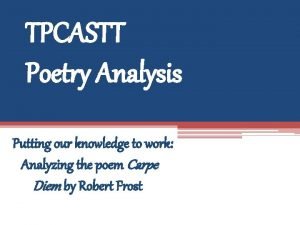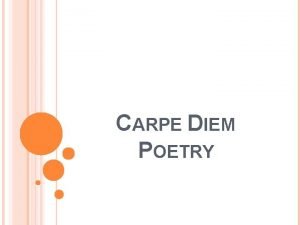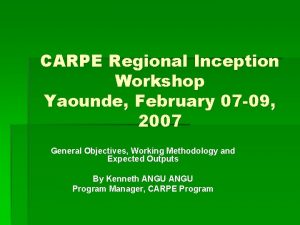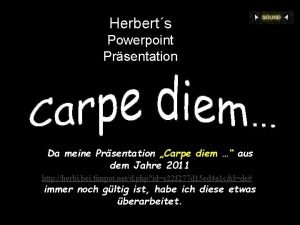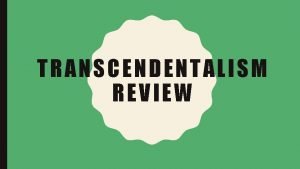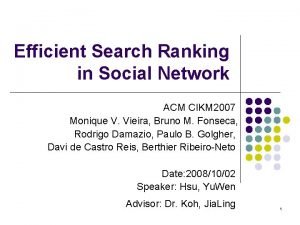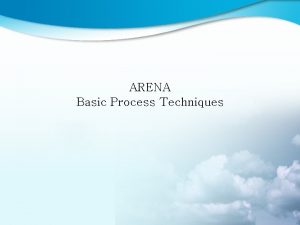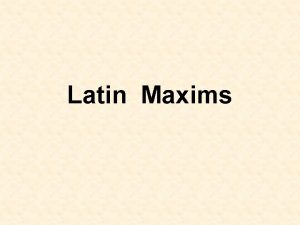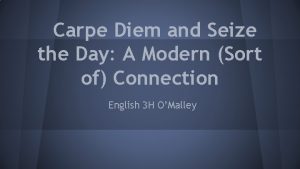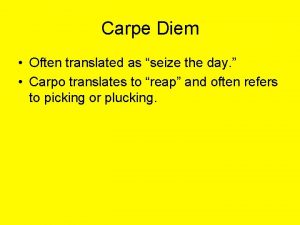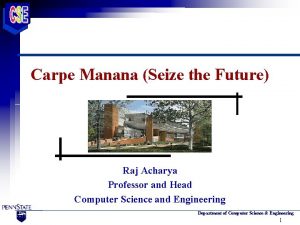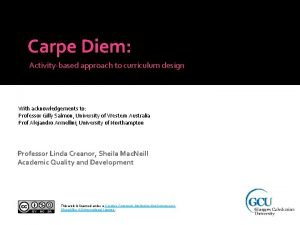CIKM Full Research Paper Carpe diem Seize the
















- Slides: 16

CIKM (Full Research Paper) Carpe diem: Seize the Samples “at the Moment” for Adaptive Batch Selection Hwanjun Song (Ph. D Student, KAIST), Minseok Kim (KAIST), Sundong Kim (IBS), and Jae-Gil Lee (KAIST)

Introduction

Training Deep Neural Networks • Stochastic Gradient Descent (SGD) with mini-batch “Randomly select mini-batch samples” Default update rule for classification Empirical risk (or loss) on mini-batch 3

Difficult-based Selection • Preferring easy samples – Selecting small-loss training samples with high probability – (Pros) Achieving a more accurate and robust network when outliers or noisy labels exist – (Cons) Slowing down the training by causing small gradients • Preferring hard samples – Emphasizing large-loss training samples with high probability – (Pros) Accelerating the training convergence of SGD – (Cons) Resulting in poor generalization on test data by exacerbating the overfitting issue 4

Uncertainty-based Selection • Preferring uncertain samples whose previous predictions were inconsistent • A recent approach: Active Bias [NIPS’ 17] Historical predictions (e. g. , predicted label or softmax prob. of target label) dog dog Certain cat Uncertain Consistent predictions Dog cat Cat-like dog Selection Prob. dog cat dog Inconsistent predictions 5

Limitation of Active Bias • Growing window scheme in Active Bias – Estimate uncertainty for the entire history of past predictions – But, older predictions could be outdated • Misclassification due to the outdated predictions Sample Uncertainty Method High Active Bias slows down the training by emphasizing uninformative samples, too easy or too hard, at the moment 6

Goal of Paper Method Fast training Better generalization Preferring easy samples X O Preferring hard samples O X Preferring uncertain samples with growing window X O Recency Bias O O Not only (1) accelerate the training speed and but also (2) improve the generalizability of the model 7

Key Idea of Recency Bias • Emphasizing only the samples recently uncertain by using a sliding window Sample Uncertainty Low Method Recency Bias Challenge 1 (C 1) Criterion to evaluate the samples uncertain at the current moment Challenge 2 (C 2) Computing the sampling probability based on the uncertainty 8

C 1: Uncertainty Criterion Previous predictions … cat dog dog Cat-like dog Empirical Entropy 9

C 2: Sampling Probability High Uncertainty Step Size: Low Uncertainty Quantized Index Exponential decaying factor Quantized Index Normalization Term 10

Decaying Selection Pressure 11

Experimental Configuration • Trained Dense. Net for the two independent tasks (1) image classification and (2) fine tuning • Used five benchmark datasets for the two tasks – Classification: MNIST, CIFAR-10, and CIFAR-100 – Fine tuning: MIT-67 and FOOD-100 • Compared four batch selection algorithms – – Random Batch (Baseline) Online Batch: Hardness-based method Active Bias: Uncertainty-based method using a growing window Recency Bias (Ours): Uncertainty-based using a sliding window 12

Task I: Image Classification • Convergence curves of training loss (training speed) Slowing down • Convergence curves of test error (generalization) 13

Task II: Fine Tuning • Results on test error – Recency Bias reduced the test error by 2. 88% and 1. 81% in MIT-64 and Food-101, respectively • Results on training time (taken to reach the same error) – Recency Bias improved the training time by 24. 57% and 26. 13% in MIT-64 and Food-101, respectively 14

Conclusions • Existing methods did not support both (1) fast training and (2) better generalization • We proposed Recency Bias, which supports both of them by emphasizing predictively uncertain samples • Uncertain samples at the moment are selected with high probability for the next mini-batch • Recency Bias indeed accelerated the training speed while achieving better generalization 15

Thank you
 Carpe diem seize the day poem
Carpe diem seize the day poem Carpe diem literatura
Carpe diem literatura Tpcastt paraphrase example
Tpcastt paraphrase example Carpe diem movie
Carpe diem movie La celestina comentario
La celestina comentario Carpe diem poem
Carpe diem poem Dead poets society latin phrase
Dead poets society latin phrase Carpe diem que havemos de esperar
Carpe diem que havemos de esperar Carpe diem yaoundé
Carpe diem yaoundé John donne carpe diem
John donne carpe diem Social commerce esempi
Social commerce esempi Carpe diem esempi
Carpe diem esempi Dead poets society phrases
Dead poets society phrases Cikm ranking
Cikm ranking Seize delay release 예시
Seize delay release 예시 List of food laws in pakistan
List of food laws in pakistan Why does prince prospero invite a thousand
Why does prince prospero invite a thousand


